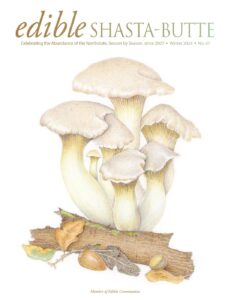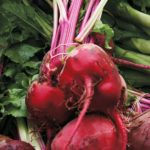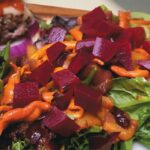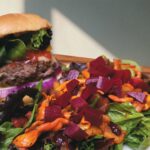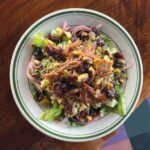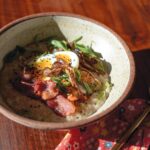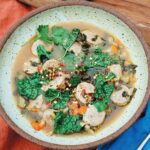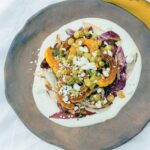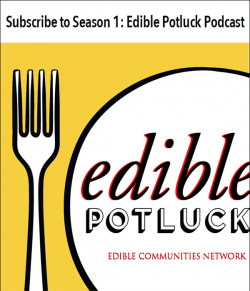
In 1980, Steve Gale purchased Stanford Oaks Estate, located on Stanford Lane adjacent to Butte Creek. Steve had moved from his Oakland home to Chico to study for a degree in Physical Education and Biology. Some of his interest in biology may have derived from his home brewing experiences with wine and beer. Like many of the students who move to Chico to attend its university, Steve fell in love with the city and became a permanent resident. After graduating in the mid-seventies, Steve found part-time employment as a teacher at Butte College and as a bartender at some of the city’s finer dining establishments.

Creasia too moved to Chico (from Redwood City) to study at the university, completing a degree that enabled her current full-time work, administering and consulting for retirement plans, serving more than 800 clients. She also fell in love with Chico and, more particularly, with the bartender she met while serving at Tres Hombres. That was nineteen years ago.
Now married, Steve and Creasia host ten to twenty weddings each year for up to 200 guests at their Stanford Lane property. These events employ outside caterers, and the Gales provide estate-bottled wine, up to three cases per wedding, along with a magnum of wine for the guests to sign instead of a guest book. Creasia, content to leave the wine making to Steve, works at Gale Vineyards’ numerous wine tasting events and in the winery’s tasting room.
|
LELAND STANFORD
|
|
Tens of thousands of Americans flowed into California in search of gold in 1849 stimulating the building of a transcontinental railroad. A group of men known as the “Big Four”—Collis P. Huntington, Mark Hopkins, Charles Crocker and Leland Stanford—amassed fortunes through its construction and also came to know of land for sale throughout California. Stanford, born in New York, moved from Wisconsin in 1852 to join two brothers already in California and opened a store in El Dorado County near the gold fields. A few years later, in 1861, Stanford was elected Governor of the state of California. A private citizen again in 1863, Stanford purchased land in Tehama County owned by Peter Lassen (renamed the Stanford Vina Ranch and the current location of New Clairvaux Vineyard) and the part of the Rancho Esquon known as the Gridley Ranch, which drew water from Butte Creek.
|
|
RANCHO ESQUON
|
|
In Stanford Ranch: Durham, Butte County, California, published by the Association for Northern California Records and Research, author Adriana Farley tells the history of Rancho Esquon. In 1844, Mexican Governor Micheltorino granted 22,194 acres of what became prime agricultural land between the present communities of Durham and its southern neighbor Gridley to pioneer Samuel Neal. The grant got its name likely because of its proximity to a village of Esken Indians. Neal used the land to raise horses for drayage and transportation and cattle for food to feed gold miners in the Sierra Nevada.
|
The Vineyard
 On their six acre estate, Steve has planted 1.2 acres in Primitivo grapes. Primitivo is a member of the Zinfandel family that originated in Croatia and proliferates in the Puglia region of Italy. Contrary to the practice in most local vineyards, Gale’s grapes are head pruned. Head pruning isolates each grape plant, rather than stringing them together on trellises. The plants are pruned to an umbrella shape with the fruit hanging down not touching anything, a method some vintners say yields a higher quality of fruit, since contact with other clusters of grapes can affect ripening and coloring and can cause bunch rot. Gale Vineyard grapes are also dry farmed. Dry farming conserves water and relies on proper tillage, creating a “dust mulch” that seals water into the ground and forces the roots of the plants deep to get the water out by capillary action. This struggle to survive gives the grapes character, expressed by the distinctive terroir of the resulting wine. The 1.2 acre plot of Primitivo grapes, when juiced, yields up to 300 cases of wine annually. Steve sources other grapes locally—Sangiovese grapes from a Durham vineyard, Temperanillo from New Clairvaux Vineyard in Vina, and Cabernet Sauvignon from several growers—Berton Bertagna in Chico, Forest Ranch grower Phil LaRocca, Lou Cecchi in Oroville, and last year one of Creasia’s Napa Valley clients. In addition to these varietals Steve’s 600 case annual production also includes Rose Primitivo (the juice is fermented without the skins to yield a lighter color) and Melange, a blend of reds that varies from year to year.
On their six acre estate, Steve has planted 1.2 acres in Primitivo grapes. Primitivo is a member of the Zinfandel family that originated in Croatia and proliferates in the Puglia region of Italy. Contrary to the practice in most local vineyards, Gale’s grapes are head pruned. Head pruning isolates each grape plant, rather than stringing them together on trellises. The plants are pruned to an umbrella shape with the fruit hanging down not touching anything, a method some vintners say yields a higher quality of fruit, since contact with other clusters of grapes can affect ripening and coloring and can cause bunch rot. Gale Vineyard grapes are also dry farmed. Dry farming conserves water and relies on proper tillage, creating a “dust mulch” that seals water into the ground and forces the roots of the plants deep to get the water out by capillary action. This struggle to survive gives the grapes character, expressed by the distinctive terroir of the resulting wine. The 1.2 acre plot of Primitivo grapes, when juiced, yields up to 300 cases of wine annually. Steve sources other grapes locally—Sangiovese grapes from a Durham vineyard, Temperanillo from New Clairvaux Vineyard in Vina, and Cabernet Sauvignon from several growers—Berton Bertagna in Chico, Forest Ranch grower Phil LaRocca, Lou Cecchi in Oroville, and last year one of Creasia’s Napa Valley clients. In addition to these varietals Steve’s 600 case annual production also includes Rose Primitivo (the juice is fermented without the skins to yield a lighter color) and Melange, a blend of reds that varies from year to year.
|
BUTTE COUNTY AGRICULTURE
|
| Located in the Sacramento Valley, a vast, flat floodplain that is particularly suited for farming, Butte County is one of the nation’s leading producers of nuts—mainly almonds and walnuts—rice, dried plums, olives, and kiwis, but it also produces abundant supplies of almost everything else (except maybe avocadoes) that a locavore needs for a healthy and delicious diet. Chico is the county’s most populous city—88,000, give or take—and is the location of a state university whose track team always performs well in the national championships, undoubtedly because of their healthy diet, but also because of the university’s proximity to Bidwell Park, with its running, biking and walking trails, where the team often runs. Durham, a chief center for agriculture, is situated seven miles south of Chico. |
The Good News!
You needn’t get married or be invited to attend a wedding at the Gale’s winery and vineyard to enjoy their wine. It is available throughout Butte County at many supermarkets and restaurants. Members of their Wine Club receive periodic shipments of various wines. Check out your options at their website: galevineyards.com. Or make an appointment for a tasting at their recently constructed tasting room. Steve and Creasia are especially proud that it is constructed of rice straw bales and, while you taste their wines, will tell you all about it.






